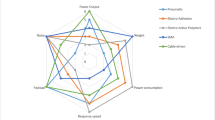Abstract
Our ability to additively combine two learned internal models was investigated by studying the forces people generate when lifting objects with a precision grip. Subjects were required to alternately lift two objects of identical physical appearance but differing weight. Grip force scaling prior to lift-off was used to estimate the output of the internal model associated with each object. Appropriate internal models were formed when alternately lifting two objects of different weight. The objects were then combined by stacking them one upon the other, and the combined object was lifted. Results show that subjects can additively combine internal models of object dynamics but the sum is biased by a default estimate of the object’s weight.


Similar content being viewed by others
References
Brashers-Krug T, Shadmehr R, Bizzo E (1996) Consolidation in human motor memory. Nature 382:252–255
Burstedt MK, Edin BB, Johansson RS (1997) Coordination of fingertip forces during human manipulation can emerge from independent neural networks controlling each engaged digit. Exp Brain Res 117:67–79
Edin BB, Westling G, Johansson RS (1992) Independent control of human finger-tip forces at individual digits during precision lifting. J Physiol 450:547–564
Flanagan JR, Beltzner MA (2000) Independence of perceptual and sensorimotor predictions in the size-weight illusion. Nat Neurosci 3:737–741
Flanagan JR, Wing AM (1995) The stability of precision grip forces during cyclic arm movements with a hand-held load. Exp Brain Res 105:455–464
Flanagan JR, Nakano E, Imamizu H, Osu R, Yoshioka T, Kawato M (1999) Composition and decomposition of internal models in motor learning under altered kinematic and dynamic environments. J Neurosci 19: RC34
Gandolfo F, Mussa-Ivaldi FA, Bizzi E (1996) Motor learning by field approximation. Proc Natl Acad Sci U S A 93:3843–3846
Ghahramani Z, Wolpert DM (1997) Modular decomposition in visuomotor learning. Nature 386:392–395
Gordon AM, Forssberg H, Johansson RS, Westling G (1991a) The integration of haptically acquired size information in the programming of precision grip. Exp Brain Res 83:483–488
Gordon AM, Forssberg H, Johansson RS, Westling G (1991b) Visual size cues in the programming of manipulative forces during precision grip. Exp Brain Res 83:477–482
Gordon AM, Westling G, Cole KJ, Johansson RS (1993) Memory representations underlying motor commands used during manipulation of common and novel objects. J Neurophysiol 69:1789–1796
Haruno M, Wolpert DM, Kawato M (2001) Mosaic model for sensorimotor learning and control. Neural Comput 13:2201–2220
Jenmalm P, Goodwin AW, Johansson RS (1998) Control of grasp stability when humans lift objects with different surface curvatures. J Neurophysiol 79:1643–1652
Johansson RS, Westling G (1984) Roles of glabrous skin receptors and sensorimotor memory in automatic control of precision grip when lifting rougher or more slippery objects. Exp Brain Res 56:550–564
Johansson RS, Westling G (1988) Coordinated isometric muscle commands adequately and erroneously programmed for the weight during lifting task with precision grip. Exp Brain Res 71:59–71
Karniel A, Mussa-Ivaldi FA (2002) Does the motor control system use multiple models and context switching to cope with a variable environment? Exp Brain Res 143:520–524
Krakauer JW, Ghilardi MF, Ghez C (1999) Independent learning of internal models for kinematic and dynamic control of reaching. Nature Neuroscience 2:1026–1031
Murray DJ, Ellis RR, Bandomir CA, Ross HE (1999) Charpentier (1891) on the size-weight illusion. Percept Psychophys 61:1681–1685
Neilson PD, Neilson MD, O’Dwyer NJ (1985) Acquisition of motor skills in tracking tasks: Learning internal models. In: Russell DG, Abernethy B (eds) Motor memory and control. Human Performance Associates, Dunedin, pp 25–36
Quaney BM, Rotella DL, Peterson C, Cole KJ (2003) Sensorimotor memory for fingertip forces: evidence for a task-independent motor memory. J Neurosci 23:1981–1986
Witney AG, Vetter P, Wolpert DM (2001) The influence of previous experience on predictive motor control. Neuroreport 12:649–653
Wolpert DM, Kawato M (1998) Multiple paired forward and inverse models for motor control. Neural Networks 11:1317–1329
Acknowledgements
We wish to thank James Ingram for his important part in developing the software used in this study. This work was supported by the Wellcome Trust.
Author information
Authors and Affiliations
Corresponding author
Rights and permissions
About this article
Cite this article
Davidson, P.R., Wolpert, D.M. Internal models underlying grasp can be additively combined. Exp Brain Res 155, 334–340 (2004). https://doi.org/10.1007/s00221-003-1730-z
Received:
Accepted:
Published:
Issue Date:
DOI: https://doi.org/10.1007/s00221-003-1730-z




